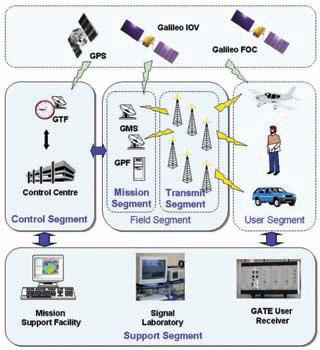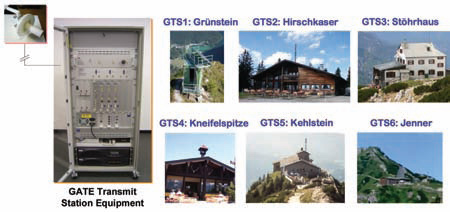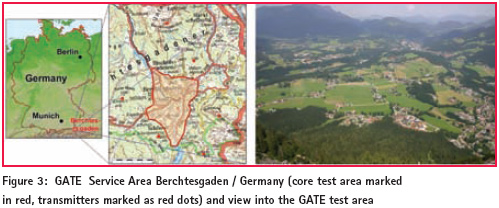| GNSS | |
GATE: A boon for Galileo
|
Guenter Heinrichs,Erwin Loehnert,Elmar Wittmann,Roland Kaniuth
|
||||
|
GATE is a ground-based realistic test environment for developers of receivers, applications and services for the future satellite navigation system Galileo. GATE is currently being builtup and as from beginning of 2008 – several years before Galileo becomes fully operational – Galileo signals will be emitted by 6 earth-fixed transmitters in the area of Berchtesgaden, located in the southeast of Germany in the German Alps. This will provide the opportunity for receiver, application and service developers to perform realistic field-tests of hardware and software for Galileo at an early stage. In this way GATE will also support German and European products for Galileo entering the market. While the motivation of the US groundbased ranging test bed Yuma in the 70’s was to prove the concept of satellite navigation, no one doubts that Galileo will work from a conceptual point of view. However, it is still an ambitious technological project, introducing a signal structure far more sophisticated than the GPS C/A Code. In fact there are three major mission objectives to be covered by GATE – Signal Experiments, Receiver Testing and User applications. GATE Infrastructure & Test AreaGATE System ArchitectureDiffering from real (navigation) satellite missionsa differentiation of the GATE system into the typical sectors Space Segment, Ground Segment and User Segment is not adequate. A division of the GATE system into the four segments – Transmit Segment (GATS), Mission The ground-based transmitters, which are part of the GATE Transmit Segment (GATS), will emit all frequencies foreseen for Galileo. Therefore they have to be flexible in signal generation and adaptive to changes in signal structure. As GATE is a real-time system it is necessary to feed the navigation message in real-time to the transmitters. They are also equipped with stable atomic clocks. The following Figure 2 shows the six envisaged transmitter locations, as well as the transmitter rack and the corresponding transmit antenna. The GATE Mission Segment (GAMS) monitors the navigation signals by using two GATE Monitoring Stations (GMS), performs the time synchronisation of all system clocks and generates navigation messages and steering commands to be sent to the six transmitters. The tasks denoted above are mainly performed by the two GAMS core elements, the GATE Processing Facility (GPF) and the GATE Monitor Receiver (GMRx), both developed by IFEN GmbH. The GATE Control Segment (GCS) includes all the functionality and facilities that are required for the mission control and operation. The main tasks it has to perform are to monitor and control the entire GATE system, to host and operate the control centre, which serves provide the GATE system time, and to archive the GATE mission data. The main tasks of the GATE Support Segment (GSS) finally comprise the appropriate preparation, i.e. simulation and planning, of the GATE experiments with dedicated software tools, as well as the provision of the GATE User Terminals equipped with a combined Galileo/GPS receiver. GATE Test Area Berchtesgaden / Germany The GATE test area is located in the region of Berchtesgaden in the very southeastern part of Germany / Bavaria. The service area is depicted in the maps shown in FIG. 8 below. The GATE test area, establishment of the GATE transmitters on well exposed positions allows for the emission of the GATE signals with average elevation angles between 10 to 15 degrees from a user’s point of view located within the GATE test area. Positioning performance in the GATE test areaStatic field tests The receiver was installed in a van with the GATE user antenna on the top of the van. The van was parked beside the road at a reference mark, which had been surveyed with a precision of 10 cm. |
||||
Pages: 1 2















 (No Ratings Yet)
(No Ratings Yet)




